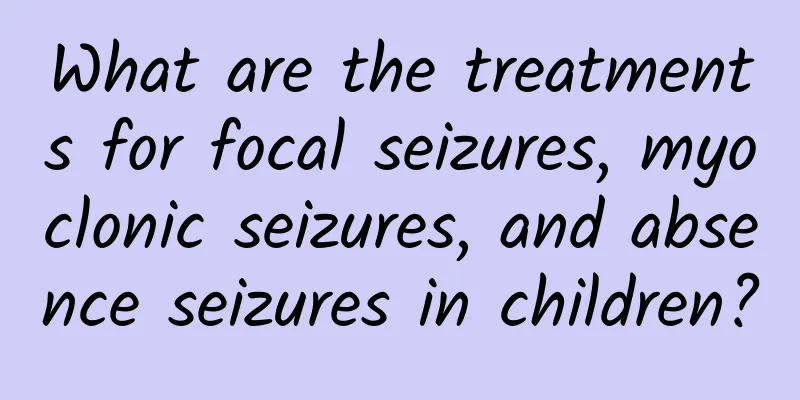What are the treatments for focal seizures, myoclonic seizures, and absence seizures in children?

|
Author: Xie Han, deputy chief physician, Peking University First Hospital Reviewer: Jiang Yuwu, Chief Physician, Peking University First Hospital Epilepsy, commonly known as "epilepsy" and "seizures", is one of the common diseases of the children's nervous system. Epilepsy is a chronic brain dysfunction with different etiologies and clinical manifestations, but with repeated epileptic seizures as a common feature. Epileptic seizures refer to transient clinical manifestations caused by abnormal excessive and synchronized discharge activities of brain neurons. The specific manifestations depend on the discharge site, intensity and range of the synchronized discharge neurons. Epileptic seizures cannot be equated with epilepsy. The former is a symptom that can be seen in patients with epilepsy, and can also be seen in non-epileptic acute brain dysfunction, such as viral encephalitis, the acute phase of various encephalopathy, etc.; the latter is a chronic brain dysfunction disease. Epileptic seizures are classified according to the clinical manifestations and EEG characteristics of the onset of the seizure, mainly into focal seizures, generalized seizures and seizures of unknown onset. Focal seizures refer to seizures that originate from a fixed unilateral hemisphere (for example, they all originate from the left hemisphere) of the epileptogenic network each time. They may or may not spread to the bilateral brain network after initiation. If they spread to both sides, they will clinically evolve into bilateral tonic-clonic seizures. Focal seizures may or may not be accompanied by impaired consciousness. Focal seizures include motor-onset and non-motor-onset. Various corresponding symptoms appear according to the different brain areas where epileptic discharges originate and spread. For example, seizures originating from the motor area of the precentral gyrus will clinically present as focal motor-onset clonic or tonic seizures. Focal seizures: Focal seizures refer to seizures that originate from a fixed unilateral hemisphere (for example, they all originate from the left hemisphere) of the epileptogenic network each time. They may or may not spread to the bilateral brain network after initiation. If they spread to both sides, they will develop into bilateral convulsions. Focal seizures may or may not be accompanied by impaired consciousness. Focal seizures include motor-onset and non-motor-onset groups. Depending on the brain area where the epileptic discharge originates and spreads, various corresponding symptoms appear, including motor symptoms such as convulsions, stiffness, and twisting of a part of the body, or sensory abnormalities such as visual abnormalities. First-line drugs for the treatment of focal seizures include oxcarbazepine, lacosamide, lamotrigine, carbamazepine, levetiracetam, valproic acid, perampanel, etc. For patients with epilepsy with focal seizures, the preferred drug should be selected based on factors such as the patient's epilepsy etiology, syndrome classification, comorbidities, drug-related adverse reactions, and drug accessibility, and close monitoring of adverse drug reactions should be performed when using these drugs. Figure 1 Original copyright image, no permission to reprint Among the common drugs used to treat focal seizures, carbamazepine, oxcarbazepine, and lamotrigine are relatively prone to allergic reactions, especially in the early stages of dosing or when the dosing rate is too fast. Therefore, during treatment with these drugs, pay attention to observe whether there are allergic symptoms, such as rash, itching, and fever and other systemic symptoms in severe cases. If you suspect a drug allergy, you need to seek medical attention and treat it in a timely manner. Myoclonic seizures: The main manifestation of myoclonic seizures is involuntary, rapid, short, electric shock-like, non-rhythmic muscle twitches, each twitch lasting about 10-15 milliseconds, rarely exceeding 100 milliseconds. Myoclonic seizures can affect the whole body or be limited to a certain muscle or muscle group. First-line drugs for the treatment of myoclonic seizures include valproic acid, levetiracetam, and topiramate. Similarly, for patients with epilepsy who have myoclonic seizures, the first choice of drug also needs to be selected based on the patient's physical condition, epilepsy characteristics, and comorbidities, and the adverse reactions of drugs should be closely monitored when using these drugs. For example, if the patient has obvious liver damage, it is not suitable to use valproic acid for treatment. Figure 2 Original copyright image, no permission to reprint In addition, a common adverse reaction of levetiracetam is irritability. If the patient has emotional problems such as irritability and temper in addition to epileptic seizures, levetiracetam is not recommended for treatment. For example, after taking topiramate, patients may experience decreased appetite, weight loss, no sweating, reduced speech, and slowed reactions. If the above adverse drug reactions occur, the treatment plan needs to be adjusted in time according to the patient's condition. As parents, before giving your children medicine, you should read the instructions to understand what adverse reactions the medicine may have. You should learn to observe whether your child has adverse reactions, discover them in time, seek medical attention in time, and deal with them in time. Absence seizures: Absence seizures are divided into two categories. One is the typical absence seizure, which occurs suddenly and stops suddenly, manifested by the sudden cessation of movement or a significant slowing down of movement. Patients have impaired consciousness during the seizure, with no or mild motor symptoms. The duration of the seizure is about 5-20 seconds. The electroencephalogram shows bilateral symmetrical and synchronous 3Hz (2.5-4Hz) spike-slow wave discharge during a typical absence seizure. Typical absence seizures can be induced by hyperventilation. The other is an atypical absence seizure, which starts and ends slower than a typical absence seizure, has a milder degree of impaired consciousness, and is accompanied by more complex motor symptoms. The duration of the seizure can exceed 20 seconds. The electroencephalogram shows slow (<2.5Hz) spike-slow wave discharge during an atypical absence seizure. The first choice drug for absence seizures in China is valproic acid, and lamotrigine is the first choice for female patients. Ethosuximide is also a first-line drug for the treatment of absence seizures, but it is not yet available in China. In fact, in the treatment of epilepsy, drug treatment for epileptic seizures is certainly important, but what is more important is the need to actively find the cause of epilepsy. The causes of epilepsy are divided into six categories: genetic, structural, metabolic, immune, infectious and unknown. If we can find a treatable cause for the patient, treatment targeting the cause is often more effective than simple anti-epileptic seizure treatment, and the patient benefits more. In addition to treatment targeting the cause and anti-epileptic drugs, there are also treatments such as ketogenic diet and vagus nerve stimulation. |
<<: Children’s urine routine test: Does positive urine sugar mean diabetes?
Recommend
What to do if you get "hot" after eating oranges, eating melon seeds, and drinking beverages during the Chinese New Year? 4 ways to relieve it
During the holidays at home, I can’t stop eating ...
What should I pay attention to during the first ultrasound during pregnancy?
B-ultrasound examination after pregnancy is a ver...
Will your beard become thicker the more you shave it?
Not really It’s a common misconception that your ...
How to regulate women who stay up late for a long time
In fact, women work harder than men. Not only do ...
What is the best way to treat fallopian tube tortuosity?
The disease of fallopian tube tortuosity is also ...
Can I eat kumquat when I'm pregnant?
Many people like to eat kumquat, but many people ...
How many days after a normal birth can I use a belly belt
During pregnancy, a woman's uterus enlarges a...
How to wash underwear
Cleaning underwear is very important for the heal...
Women are more afraid of cold in autumn and winter. Have you found the reason?
Have we discovered that women are more afraid of ...
Pictures of scars after laparoscopic surgery
Laparoscopy is to make an incision on the abdomen...
Why does myocardial infarction occur?
6 warning signs before a meme comes! Remember the...
What causes itchy nipples during puberty?
In daily life, many women will experience itchy n...
Does immunity decrease before menstruation?
I believe that most female friends are familiar w...
Signs of sexual desire in women
As the saying goes, women are like wolves at thir...









